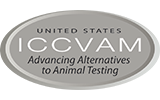Development of High-throughput Assays to Detect Potential Sensitizers or Irritants
Assessing the sensitization or irritation potential is a key element in the safety evaluation of topically applied or exposed chemicals and drugs. European legislation now mandates the use of alternative test methods for these compounds, instead of testing them on animals. Developing HTS assays for these compounds would provide a faster and cheaper alternative testing method than current in vitro assays. Scientists from NIEHS and NCATS collaborated to explore development of HTS approaches to identify potential irritants and sensitizers. Studies described in a 2020 publication (Wei et al. 2020) found that HTS-compatible 2D cellular and 3D tissue skin models could be combined with irritation-relevant activity endpoints to assess the irritation effects of topical-use compounds and identify potential hazards. To identify potential skin sensitizers, the Tox21 10K compound library was screened for potential sensitizers using the KeratinoSens assay. Substances identified as active were further tested using a high-throughput version of the direct peptide reactivity assay (Wei et al. 2021), an interleukin-8 assay, and the human cell line activation test. Analysis of these data are ongoing, and the results will be reported in a paper to be published in 2022.



